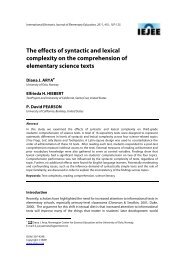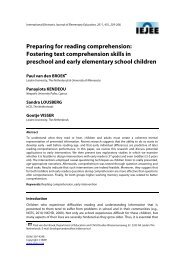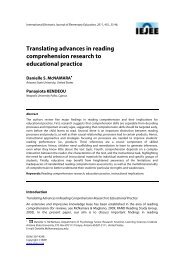Individual differences in children's knowledge of expository text ...
Individual differences in children's knowledge of expository text ...
Individual differences in children's knowledge of expository text ...
Create successful ePaper yourself
Turn your PDF publications into a flip-book with our unique Google optimized e-Paper software.
International Electronic Journal <strong>of</strong> Elementary EducationDepartment <strong>of</strong> Education, is focused on structure strategy <strong>in</strong>struction for students <strong>in</strong> Grades 4-8. Shehas served on editorial boards for Discourse Processes, the Journal <strong>of</strong> Educational Psychology, theRead<strong>in</strong>g Research Quarterly, Cognition and Instruction, the Educational Psychologist, and the Journal <strong>of</strong>Literacy Research and is a Fellow <strong>in</strong> the American Psychological Association, American EducationalResearch Association, and American Psychological Society.ReferencesAlvermann, D. E., & Hague, S. A. (1989). Comprehension <strong>of</strong> counter<strong>in</strong>tuitive science <strong>text</strong>: Effects <strong>of</strong> prior<strong>knowledge</strong> and <strong>text</strong> structure. The Journal <strong>of</strong> Educational Research, 82, 197-202.Armand, F. (2001). Learn<strong>in</strong>g from <strong>expository</strong> <strong>text</strong>s: Effects <strong>of</strong> the <strong>in</strong>teraction <strong>of</strong> prior <strong>knowledge</strong> and<strong>text</strong> structure on responses to different question types. European Journal <strong>of</strong> Psychology <strong>of</strong>Education, 16, 67-86.Armbruster, B. B., Anderson, T. H., & Ostertag, J. (1987). Does <strong>text</strong> structure/summarization <strong>in</strong>structionfacilitate learn<strong>in</strong>g from <strong>expository</strong> <strong>text</strong>? Read<strong>in</strong>g Research Quarterly, 22, 331-346.Best, R. M., Floyd, R. G., & McNamara, D. S. (2008). Differential competencies contribut<strong>in</strong>g to <strong>children's</strong>comprehension <strong>of</strong> narrative and <strong>expository</strong> <strong>text</strong>s. Read<strong>in</strong>g Psychology, 29, 137-164.Birkmire, D. P. (1985). Text process<strong>in</strong>g: The <strong>in</strong>fluence <strong>of</strong> <strong>text</strong> structure, background <strong>knowledge</strong>, andpurpose. Read<strong>in</strong>g Research Quarterly, 20, 314-326.Britton, B. K., Meyer, B. J., Hodge, M. H., & Glynn, S. M. (1980). Effects <strong>of</strong> the organization <strong>of</strong> <strong>text</strong> onmemory: Tests <strong>of</strong> retrieval and response criterion hypotheses. Journal <strong>of</strong> ExperimentalPsychology: Human Learn<strong>in</strong>g and Memory, 6, 620-629.Coté, N., Goldman, S. R., & Saul, E. U. (1998). Students mak<strong>in</strong>g sense <strong>of</strong> <strong>in</strong>formational <strong>text</strong>: Relationsbetween process<strong>in</strong>g and representation. Discourse Processes, 25, 1-53.Danner, F.W. (1976). Children's understand<strong>in</strong>g <strong>of</strong> <strong>in</strong>tersentence organization <strong>in</strong> the recall <strong>of</strong> shortdescriptive passages. Journal <strong>of</strong> Educational Psychology, 68, 174-183.Duke, N. K. (2000). 3.6 m<strong>in</strong>utes per day: The scarcity <strong>of</strong> <strong>in</strong>formational <strong>text</strong>s <strong>in</strong> first grade. Read<strong>in</strong>gResearch Quarterly, 35, 202-224.Englert, C. S., & Hiebert, E. H. (1984). Children's develop<strong>in</strong>g awareness <strong>of</strong> <strong>text</strong> structures <strong>in</strong> <strong>expository</strong>materials. Journal <strong>of</strong> Educational Psychology, 76, 65-74.Englert, C. S., & Thomas, C. C. (1987). Sensitivity to <strong>text</strong> structure <strong>in</strong> read<strong>in</strong>g and writ<strong>in</strong>g: A comparisonbetween learn<strong>in</strong>g disabled and non-learn<strong>in</strong>g disabled students. Learn<strong>in</strong>g Disability Quarterly,10, 93-105.Frederiksen, C. H. (1975). Represent<strong>in</strong>g logical and semantic structures <strong>of</strong> <strong>knowledge</strong> acquired fromdiscourse. Cognitive Psychology, 7, 371-458Garner, R., & Gill<strong>in</strong>gham, M. G. (1987). Students' <strong>knowledge</strong> <strong>of</strong> <strong>text</strong> structure. Journal <strong>of</strong> Read<strong>in</strong>gBehavior, 19, 247-259.Garner, R., Alexander, P., Slater, W., Hare, V. C., Smith, T., Reis, R. (1986). Children's <strong>knowledge</strong> <strong>of</strong>structural properties <strong>of</strong> <strong>expository</strong> <strong>text</strong>. Journal <strong>of</strong> Educational Psychology, 78, 411-416.Goldman, S. R., Rakestraw J. A. (2000). Structural aspects <strong>of</strong> construct<strong>in</strong>g mean<strong>in</strong>g from <strong>text</strong>. In M. L.Kamil, P. B. Mosenthal, P. D. Pearson & R. Barr (Eds.), Handbook <strong>of</strong> read<strong>in</strong>g research: Volume III(pp. 311-335). Mahwah, New Jersey: Lawrence Erlbaum Associates.Hiebert, E. H., Englert, C. S., & Brennan, S. (1983). Awareness <strong>of</strong> <strong>text</strong> structure <strong>in</strong> recognition andproduction <strong>of</strong> <strong>expository</strong> discourse. Journal <strong>of</strong> Read<strong>in</strong>g Behavior, 15, 63-79.Kardash, C. M., & Noel, L.K. (2000). How organizational signals, need for cognition, and verbal abilityaffect <strong>text</strong> recall and recognition. Contemporary Educational Psychology, 25, 317-331.K<strong>in</strong>tsch, W. (2004). The construction-<strong>in</strong>tegration model <strong>of</strong> <strong>text</strong> comprehension and its implications for<strong>in</strong>struction. In R. B. Ruddell, & U. J. Norman (Eds.), Theoretical models and processes <strong>of</strong> read<strong>in</strong>g(5th ed., pp. 1270-1327). Newark, DE: International Read<strong>in</strong>g Association.K<strong>in</strong>tsch, W., & Yarbrough, J. C. (1982). Role <strong>of</strong> rhetorical structure <strong>in</strong> <strong>text</strong> comprehension. Journal <strong>of</strong>Educational Psychology, 74, 828-834.Loman, N. L., & Mayer, R. E. (1983). Signal<strong>in</strong>g techniques that <strong>in</strong>crease the understandability <strong>of</strong><strong>expository</strong> prose. Journal <strong>of</strong> Educational Psychology, 75, 402- 412.80





